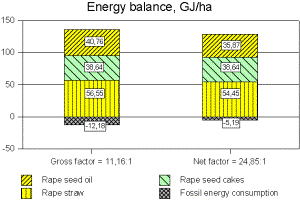|
BIODIESEL |
|
|
With properties very similar to those of fossil diesel, biodiesel can go almost directly into existing diesel vehicles and it mixes with fossil diesel in any ratio. The energy content is about 8% lower, but it has higher fuel density and better ignition quality with its higher cetane number than ordinary diesel fuel. Biodiesel is the only alternative fuel that can be used by any conventional diesel engine. Blends of 20% biodiesel with 80% petroleum diesel (B20) can generally be used in unmodified diesel engines. However users should check the engine warranty statement. Biodiesel can also be used in its pure form (B100), but it may require certain engine modifications to avoid maintenance and performance problems during wintertime utilization.
Biodiesel
can be stored anywhere like petroleum diesel. Chemically biodiesel is 11% oxygen
by weight and contains no sulfur. Its use can extend the life of diesel engines
because it is more lubricating than ordinary diesel fuel, while fuel
consumption, ignition, power output, and engine torque are relatively
unaffected.
Biodiesel is safe to handle and transport and offers benefits over diesel fuel
because it is much less combustible, with a flash point higher than 150°C,
compared to 77°C for diesel. It is as biodegradable as sugar and 10 times less
toxic than table salt. When burned in a diesel engine, biodiesel replaces the
exhaust odor of petroleum diesel with the acceptable smell of kitchen
odors like French fries or popcorn.
Biodiesel is a renewable fuel that can be manufactured from vegetable oils, animal fats, or recycled restaurant greases. Oil plants are grown in most parts of the world. Extracted oil is only one of the products which arises from production of biodiesel. By-products can be used as a fodder or even as the fuel for heating purposes. Therefore biodiesel production can be integrated in the local agriculture and even lead to the creation of the whole new local industry and market. Biodiesel can be produced domestically and thus can improve the situation in agricultural sector. It can bring new income for farmers and solve the problems with overproduction of food in some countries.

Biodiesel fuelled bus in Graz, Austria.
Biodiesel can be made from many oils and fats such as rape seed, palm oil, sunflower, soy, canola, tallow, mustard or even from used vegetable oils and animal fats. All these feedstocks are nontoxic, biodegradable and renewable resources. Biodiesel production begins with pressing the plant seeds, which yields an oil fraction to be later converted to biodiesel and a by-product so called oil cake which can be used as cattle feed. Raw oil needs filtering and estherification - the process transforming large-branched molecule structure into smaller molecules similar to the ordinary fossil fuel based diesel. Fats or raw oils are chemically reacted with an alcohol (usually methanol) during estherification process in order to get methylesther (biodiesel) and glycerine another by-product used in the pharmaceutical and cosmetics industries.
Top five biodiesel producers in 2005.
|
Production (million liters) |
|
| Germany | 1,920 |
| France | 511 |
| United States | 290 |
| Italy | 227 |
| Austria | 83 |


Using biodiesel in a conventional diesel engine substantially reduces emissions of hydrocarbons, carbon monoxide, sulfates, aromatic hydrocarbons, and particulate matter. Most importantly, biodiesel reduces air toxics and cancer-causing compounds. Pure biodiesel (100% biodiesel) can reduce the cancer risks by 94 percent. Mixture of 20 percent of biodiesel and 80 percent of petroleum diesel (B20) will reduce that risk by as much as 27%. Biodiesel does not contain sulfur, so it will not contribute to sulfur dioxide emissions. Due to the fact that more oxygen in biodiesel leads to more complete combustion into CO2, biodiesel decreases the solid carbon fraction of particulate matter in emissions. Therefore, biodiesel works well with emission control technologies such as diesel oxidation catalysts. Pure biodiesel burning reduces carbon dioxide emissions by more than 75% over petroleum diesel. Using a blend of 20% biodiesel reduces carbon dioxide emissions by 15%.
Emissions from pure biodiesel combustion (B100).
| Biodiesel vs. diesel emissions | |
| Carbon monoxide | – 45 % |
| Hydrocarbons | – 56 % |
| Particulates | – 55 % |
| Nitrous oxides | + 5 % |
| Mutagenicity | – 80 % - 90 % |
It would seem obvious to cover the agricultural industry's own energy consumption directly through biomass. Typically the agricultural machinery could be run on biodiesel what will lead to immediate environmental improvements in agriculture. Among other things, spillage and leaking of fuel would be harmless. In Germany, tractors run on biodiesel, primarily because of environmental considerations.
Greenhouse
gas emissions

Plants that produce oils seeds, which are used for cooking or making biodiesel, absorb CO2 from the atmosphere to build stems, leaves, seeds and roots. When the biodiesel is burned and the leftover plant material decomposes, carbon dioxide returns the carbon from the fuel and plant matter to the atmosphere again as carbon dioxide (CO2). This recycling of carbon from CO2 in the atmosphere to carbon in plant material and back to the atmosphere results in no accumulation in the atmosphere.
Based on a report by the US DOE and USDA entitled "Life Cycle Inventory of Biodiesel and Petroleum Diesel for Use in an Urban Bus" biodiesel produced from soy has an energy balance (output:input ratio) of 3,2:1. That means that for each unit of energy put into growing the soybeans and turning the soy oil into biodiesel, we get back 3,2 units of energy in the form of biodiesel. That works out to an energy efficiency of 320%. The reason for the energy efficiency being greater than 100% is that the growing soybeans turn energy from the sun into chemical energy (oil). With the improved energy balances of other crops such as palm oil, waste oils, mustard or algae, this energy balance is usually even better (see the table).
Energy balance of biodiesel.
| Feedstock | Output : Input ratio | Reference |
|
Biodiesel (palm oil) |
9 | (8.66)
Azevedo
(~9) Kaltner (9.66) Azevedo |
| Biodiesel (waste vegetable oil) | 5 - 6 | (4.85–5.88) Elsayed et al. |
|
Biodiesel (soybeans) |
3,2 |
(1.43–3.4) Azevedo et al. (3.2) Sheehan et al. |
|
Biodiesel (rapeseed, EU) |
2,5 |
(1.2–1.9) Azevedo et al. (2.16–2.41) Elsayed et al. (2–3) Azevedo et al. (2.5–2.9) BABFO (1.82–3.71) Richards (2.7) NTB (2.99) ADEME/DIREM |
Winter rape
One of the many possible plant oil sources for transportation is the winter rape, which is grown in Europe. The oil produced is useful both as food and as fuel, while the press cake is a valuable fodder. Winter rape can be produced through pesticide-free cultivation. In general pesticide-free cultivation of agricultural products results in a large overall yield loss (23% in average for corn), but according to Danish experience such cultivation is least affected for winter rape, with only 7 % yield loss. Winter rape is now finding a place as a natural part of Danish organic agriculture. The production has increased by a factor of four in just two years.
STRAIGHT
VEGETABLE OIL (Cold Pressed)
Another method for running a diesel engine on vegetable oil is to use straight (pure) vegetable oil. As with the other methods it is possible to use either pure vegetable oil or used cooking oil. To ensure the reliability and longevity of diesel engine, the engine must be slightly upgraded or in case of bi-fuel cars even use an extra fuel tank and a valve to switch between the tank of diesel an the tank of vegetable oil. The changes on engine must ensure that the vegetable oil is heated to at least 70°C.
FOLKECENTER WINTER RAPE SEED OIL UTILIZATION
The cold pressed rape seed oil presents the energetically and environmentally best alternative to fossil diesel with a strongly positive energy and CO2 balance. The use of rape seed oil for transport can substitute the agricultural industry's own fuel consumption. It is estimated that with conventional cultivation of winter rape, the total fuel consumption of the Danish agricultural industry could be covered by 10% of the agricultural area along with covering 20% of the protein fodder consumption and 81% of agriculture's total gross energy consumption.
Agriculture and forestry are the only production industries which are directly based upon solar energy. This is done through production of various forms of biomass which can be used for food, directly and indirectly in the form of fodder, and for energy. From a general consideration of sustainability, it would therefore be natural for agriculture to contribute a significant part of the country's energy supply.
Cold pressed rape seed oil can substitute diesel after a minor modification of the engine. The oil presents no fire and health hazards, and it is nonpolluting. The oil is pressed in an inexpensive plant with a low energy consumption, and the whole production can take place at the individual farm. This is in contrary to biodiesel production (eshterification) which needs an industrial process with a high energy consumption an expensive centralised production plant. Consequently, the cold pressed rape seed oil presents energetically and environmentally best alternative to fossil diesel. The energy and CO2 balance for the rape crop is also strongly positive.
Energy
balance
No matter whether gross or net calculations are used, and no matter whether the contribution from the rape cake is included or excluded, the conclusion is that the energy balance is strongly positive.
Energy consumption:
Calculated with the Danish Energy Agency's method with correction for the differences between cold pressed rape seed oil and biodiesel, the gross energy consumption for cultivation and processing amounts to 10,83 MJ/l rape seed oil, corresponding to 3,922 GJ/ton rape seed or 12,2 GJ/ha. Of the 12,2 GJ/ha, 7,0 GJ/ha comprises local energy consumption in the form of 4,9 GJ/ha diesel oil and 2,1 GJ/ha electricity; this local fossil energy consumption can be replaced by renewable energy from the crop in the form of rape seed oil and electricity produced from rape straw.
Energy yield:
Harvest from the area of 1 ha of rape can yield to:
1) rape seed = 3 tons, which gives:
- rape seed oil = 1 ton = 1086 l rape seed oil, which corresponds to 1032 l diesel
- rape cakes = 2 ton
2) rape straw = 3,9 ton
Gross energy contents:
rape seed oil : 37,53 MJ/l x 1086 l/ha = 40,76 GJ/ha (30%)
rape cakes : 19,32 MJ/kg x 2000 kg/ha = 38,64 GJ/ha (28%)
rape straw : 14500 MJ/ton x 3,9 ton/ha = 56,55 GJ/ha (42%)
Total: 135,95 GJ/ha (100%)
As it appears, the total gross energy content in the crop is 135,95/12,2 = 11,16 times greater than the actual fossil gross energy consumption. With local use of renewable energy, the net energy content in the crop is even higher - 24,85 times greater than the actual fossil gross energy consumption.

The energy content in the rape straw is a 4,5 times higher than the total gross energy consumption. It may be noted that, as an alternative to fodder, the energy content in the rape cakes may be used for energy production, either in a biogas plant or as fuel in combined heat and production plant or heat producing plants.